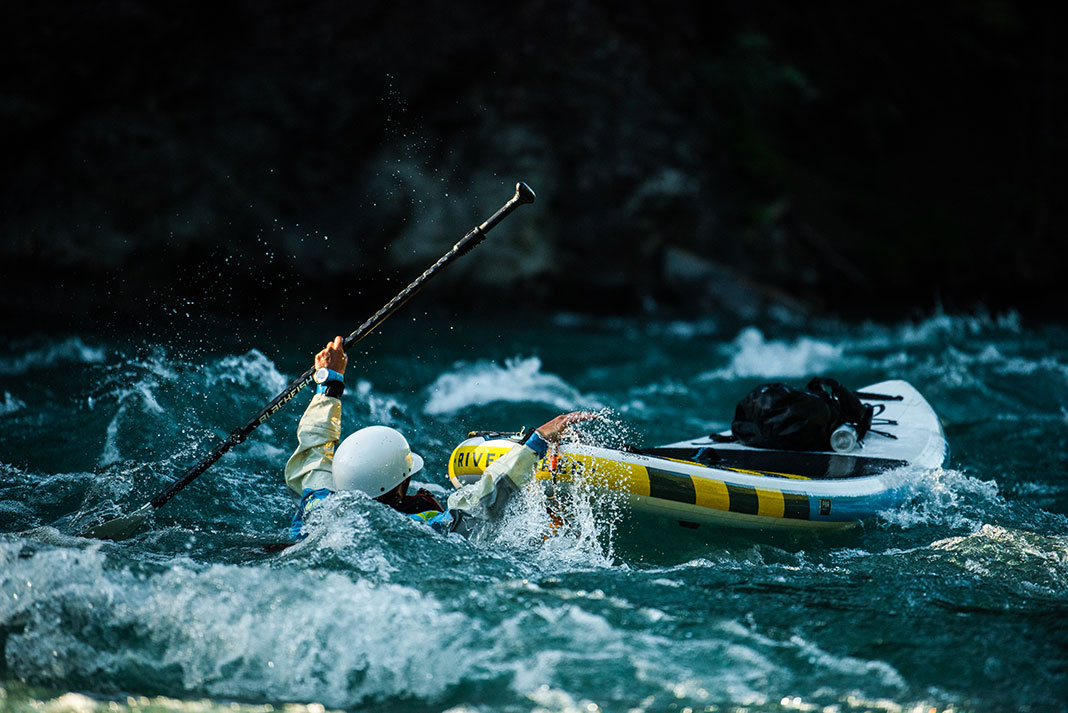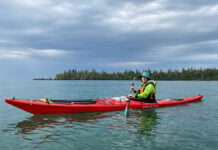ASUP leash is a plastic cord connecting paddleboard to paddler. It’s an essential piece of safety equipment for flatwater paddling and ocean surfing, ensuring the paddler doesn’t become separated from their board in an upset. However, using a leash in the river environment is a contentious topic.
That’s because any line in moving water is an entrapment hazard. If a leash catches on a rock or strainer, even a relatively minimal current can anchor a paddler underwater. American Whitewater’s accident database reports seven board-related fatalities on moving water in the U.S. within the past five years. Of those, four involved leashes. Anecdotally, there are many more near misses.
SUP leashes on the river—yea or nay?
“Avoiding entrapment is a key concept for whitewater paddling, and a long, dangling rope carries that risk, even when on a quick-release,” cautions Danny Peled, director of Boreal River Rescue. “There are a lot of times where river paddleboarders shouldn’t be wearing leashes, but they saw other people doing it, or it seems acceptable. There’s no other situation where whitewater paddlers would have a long, dangly thing hanging. In many cases, the risks outweigh the benefits.”
The ACA also takes a conservative approach to leash use in moving water. It recommends leashes might be appropriate on large-volume rivers with deep rapids and swift currents free of obstructions. A swiftwater safety course is the best way to get educated to judge the appropriateness of using a leash based on the river in question and its current conditions.

Those who use leashes on the river argue they’re potentially a lifeline, keeping a paddler connected to their gear and board—which is an additional flotation device—and that a leash allows the paddler to swim without worrying about board management. In some high flow situations or on remote trips, the risk of losing a board may also outweigh the risk of entrapment.
“I always wear a leash. I see value in using it, and I respect it and am aware of its dangers,” says Melanie Seiler, a SUP instructor, former state director for the American Canoe Association (ACA), and current executive director of Active Southern West Virginia. Seiler grew up on Appalachian whitewater and views leashes as essential gear allowing paddlers to quickly get back on their boards where they’re safest.
River versus flatwater SUP leash usage
When using a leash on the river, it should never be attached to the ankle or leg, as is typical in flatwater SUP. This is because it may be impossible for the paddler to bend against the current and reach upstream to release the leash in an entrapment scenario. A leash used in moving water must instead be attached at or above the waist, reachable by both hands, and on a quick-release system. Coiled leashes are preferred for river use to keep the leash out of the water and prevent snagging.
Seiler encourages regular practice with the quick-release system for extreme situations. “There has to become some muscle memory to make it happen in a situation it’s designed for: You’re in rushing water and pinned. Your eyes are closed, and your hand is finding the release mechanism and feeling how hard you have to pull it and in what direction to get it to come loose. All at a time you’d be freaking out.”
There are also a few circumstances where Seiler doesn’t promote leashes, such as when she teaches beginner classes on flat rivers, or when the leash poses a significant risk of entanglement with others, as at mass start races.
Auto-fail points can save you in a pinch
Standup paddleboarding isn’t the only board sport making its way from the coast to interior whitewater over the past decade. River surfing continues to gain popularity, especially as stationary waves take shape in outdoor towns globally. The risks of leashes are also discussed in the fledgling river surf community, according to Neil Egsgard, president of the Alberta River Surfing Association and founder of the Calgary-based stationary wave design firm, Surf Anywhere.
At the waves Surf Anywhere has designed, Egsgard’s company places signage reading: “Danger. All leashes can drown river surfers. Current will not let go. Surfer cannot release. Do not wear a leash or do have a leash auto-fail point at the body.”
“A common misconception is [quick-release] leashes are always releasable,” says Egsgard. “Taking a whitewater safety course with professionals quickly reveals releasing leashes under tension can be very challenging.”
Egsgard argues manual quick-release systems can fail and recommends river surfers and paddleboarders wear leashes that also have an auto-fail point. This component, such as a low-strength cord or a plastic strap, is manufactured to break under tension. If a paddler becomes trapped and cannot activate their quick release, this component will break and the paddler will float free.
To leash or not to leash?
Ultimately, there’s no one correct answer to the question of leashes on the river. Safety equipment needs to be tailored to the specific river environment and it’s each paddler’s responsibility to get the education to make informed decisions about where a leash is appropriate.
This article was first published in the Early Summer 2022 issue of Paddling Magazine. Subscribe to Paddling Magazine’s print and digital editions, or browse the archives.
To leash or not to leash? Either way, river paddleboarders also need to wear all the essentials of whitewater paddling, including helmet and inherently buoyant PFD. | Feature photo: Ashley Voykin








The safe path to go SUP in Whitewater:
Step 1: Get very good in flat water (stability, bracing, falls)
Step 2: Follow a whitewater rescue training that include practice of the quick release in real current.
Step 3: Follow a whitewater SUP training
Step 4: Get the right equipment, practice your skills in easy river with at least 2 other properly trained buddy.
If you don’t have the training, don’t use a leash in whitewater. And avoid whitewater in the first place!
Alex Dematane
Whitewater Rescue Instructor with 20+ years of experience.
I, myself, have a leash for my whitewater SUP, but every time I use it I feel uncomfortable for a multitude of reasons so I really don’t use it. I feel pretty comfortable and able to grab my board in one hand and paddle in the other and float downstream on my back during swims and that has worked well for me without any injuries or loss of my board. Of course, as your article states, one scenario where a leash makes more sense is in very deep and swift water that has no obstructions for a leash to get caught in, but of course, we don’t have rivers like that in the NE!
Great article, Joey! Always love reading what you’ve been up to and researching!
Colleen & Peter
really interested in the idea of the leash autofail. However, I can’t find any information anywhere online about where to get one, how to make one or what to use. Can you give me any pointers on this?
Palm Equipment and Whettman make them
Ran into this article in March 2024. I am an experienced river surfer (not SUP surfer) so only commenting on quick release leashes from a river surfing perspective. The SUP community of any type has to figure this out on their own.
Currently there are NO safe quick release leashes (QR leashes) on the market because no QR leashes are manufactured/sold with a self-releasing component as fail-safe backup to the QR leash. Hopefully that will change, though some people are retrofitting QR leashes (typically the XM and DaKine QR calf/knee leashes) but those are NOT tested under legit lab conditions…
The snap shackle QR leash is particularly very dangerous because it has caused NDEs for river surfing and was involved in a recent SUP fatality. The snap shackle QR leash is a preventive safety tool and not a re-active safety tool as evidenced by NRS user instructions (pull when faced with a potential hazard and no language on how to pull when held underwater, see https://dh36nblqpps8a.cloudfront.net/assets/downloads/nrs/49115_QRSUPLeash_Instructions.pdf). Also the snap shackle QR leash is known to break and not pull the pin when the user tries to pull the release ball from the wrong angle. Additionally the snap shackle QR leash has been known to fall apart (pull-ball on string falls off). Lastly, finding the snap shackle QR release is very difficult to impossible during the very brief time a person has held underwater to deploy the snap shackle QR leash before drowning.
Additionally the QR leash on a “rescue pfd” is not designed for day-in day-out use in river surfing. A rescue pfd is called a rescue pfd because it is used in “rescue” situations and NOT designed for layperson use or even trained person to use jumping on a river wave in a non-rescue fashion. Rescue vests should only be used by swift water trained persons for rescue situation and must properly thread the belt on the rescue pfd (note, one manufacturer claims 1 in 4 rescue vests fail to release due to improper threading.. that is a 25% failure rate!!!).
The closest we have for empirical data on QR leashes comes from a Sept 2023 university lab study commissioned by the British Canoe Assoc (now known as “UK Paddle”). In that study the rate of failure to be able to find and release the QR leash was so bad that, the UK Paddle immediately banned all QR leashes from their events and recommended that NO leash system of any kind be used in the whitewater environment.
RIVER SURFERS SHOULD IMMEDIATELY STOP USING QR LEASHES OF ANY TYPE UNTIL: 1) Proper safety protocols are developed (none exists except for people saying take a swift water rescue class, that does not address typical river surfing activity in any real fashion; AND, 2) A modern self-releasing leash is invented/tested/certified for sale to the public…. This means river waves that require a leash to surf (rapids below, bad eddy service, etc) should be done at persons own knowledge and peril that QR leashes have a high failure rate. In other words, don’t river surf river waves that require a leash until a self-releasing QR leash becomes available with instructions of how to use them….. Luckily, many river waves can be safely river surfed without a leash when conditions are not too heavy.
*Again, the SUP community is on its own on reviewing and making any safety protocol changes to the QR leashes they use. I have no right to make suggestions to the SUP community other than, what works for SUP does NOT automatically work for river surfing; and when it comes to the QR leash, the QR leashes used for SUP are deadly to river surfers.